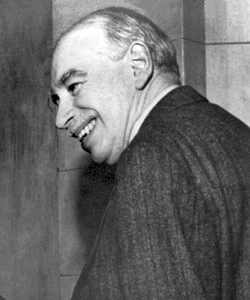Bancor
This article needs additional citations for verification. (March 2009) |

The bancor was a supranational currency that John Maynard Keynes and E. F. Schumacher[1] conceptualised in the years 1940-42 and which the United Kingdom proposed to introduce after the Second World War. This newly created supranational currency would then be used in international trade as a unit of account within a multilateral clearing system – the International Clearing Union – which would also have to be founded.
John Maynard Keynes proposed an explanation for the ineffectiveness of monetary policy to stem the depression, as well as a nonmonetary interpretation of the depression, and finally an alternative to a monetary policy for meeting the depression. Keynes believed that in times of heavy unemployment, interest rates could not be lowered by monetary policies. The ability for wealth to move between countries seeking the highest interest rate frustrated Keynesian policies. By closer government control of international trade and the movement of wealth, Keynesian policy would be more effective in stimulating individual economies.
Bancor would not be an international currency. It would rather be a unit of account used to track international flows of wealth. Gold could be exchanged for bancors, but bancors could not be exchanged for gold. Individuals could not hold or trade in banor. All international trade would be valued and cleared in Bancor.
Keynes was able to make his proposal the official British proposal at the Bretton Woods conference. But it was not accepted. Rather than a supranational currency, the conference adopted a system of pegged exchange rates ultimately tied to physical gold in a system managed by the World Bank and IMF. In practice, the system implicitly established the U.S. dollar as a reserve currency convertable to gold at a fixed price on demand by other governments. The dollar was implicitly established as the reserve by the large trade surplus and gold reserves held by the US at the time of the conferenece.
Since the outbreak of the financial crisis in 2008 Keynes's proposal has been revived: In a speech delivered in March 2009 entitled Reform the International Monetary System, Zhou Xiaochuan, the governor of the People's Bank of China called Keynes's bancor approach "farsighted" and proposed the adoption of International Monetary Fund (IMF) special drawing rights (SDRs) as a global reserve currency as a response to the financial crisis of 2007–2010. He argued that a national currency was unsuitable as a global reserve currency because of the Triffin dilemma - the difficulty faced by reserve currency issuers in trying to simultaneously achieve their domestic monetary policy goals and meet other countries' demand for reserve currency.[2][3] A similar analysis can be found in the Report of the United Nation's "Experts on reforms of the international monetary and financial system" [4] as well as in the IMF's study published on April 13, 2010 [1][5]
See also
- International Clearing Union
- United Nations Monetary and Financial Conference
- John Maynard Keynes
- IMF special drawing rights (SDRs)
- Triffin dilemma
- New World Order
References
- ^ E. F. Schumacher, Multilateral Clearing Economica, New Series, Vol. 10, No. 38 (May, 1943), pp. 150-165
- ^ Xiaochuan, Zhou (2009). "Reform the International Monetary System" (PDF). BIS Review. Bank of International Settlements. Retrieved 2010-11-28.
- ^ http://www.ft.com/cms/s/0/7851925a-17a2-11de-8c9d-0000779fd2ac.html
- ^ Recommendations by the Commission of Experts of the President of the General Assembly on reforms of the international monetary and financial system, 20.3.2009. http://www.un.org/ga/president/63/letters/recommendationExperts200309.pdf
- ^ Reserve Accumulation and International Monetary Stability, 13.4.2010, http://www.imf.org/external/np/pp/eng/2010/041310.pdf
Friedman. M., (1968) The American Economic Review, Vol. 58, No. 1, 1-17 http://wenku.baidu.com/view/773632c79ec3d5bbfd0a7430.html?from=related</ref>
Further reading
- John Maynard Keynes (1980), The Collected Writings, Volume XXV: Activities, 1940-44 - Shaping the Post-war World: The Clearing Union., Basingstoke
{{citation}}: CS1 maint: location missing publisher (link) - Armand van Dormael (1978), Bretton Woods. Birth of a Monetary System., London, ISBN 978-0-8419-0326-5
{{citation}}: CS1 maint: location missing publisher (link)
